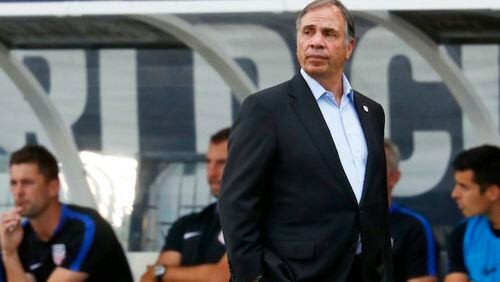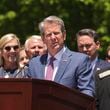Instead of collapsing to the water-logged pitch and burying their head in their hands, instead of ruing Clint Dempsey's shot that hit the post or Omar Gonzalez's clearance that spun into his own net, instead of trudging to the locker room at Ato Boldon Stadium in disbelief and despair, members of the U.S. men's national soccer team should have approached the celebrating players from the Caribbean nation that had lost seven straight games and was ranked No. 99 in the world.
And thanked them.
This is the best thing that has ever happened to American soccer. Or it should be.
The 2-1 loss Tuesday night to a collection of islanders from clubs with names like W Connection, Defense Force and St. Ann's Rangers eliminated the nation of 326 million with pristine fields and youth clubs everywhere and a federation with a $100 million surplus from the 2018 World Cup. It's a tough, cruel dose of reality spooned up by the fickle soccer gods, and a necessary one.
The window for change was closing. It already was too easy qualifying for the World Cup out of a CONCACAF region of Caribbean islands and impoverished Central American nations, too easy for the U.S. Soccer suits to stick out their chest and proclaim progress by qualifying five, six, seven straight times. And in 2026 it is going to get even easier when FIFA expands its marquee event to 48 teams. Win a two-leg series against St. Vincent and the Grenadines, and you're in.
The complacency, the entitlement, the arrogance, the lack of humility, the lack of vision would perpetuate indefinitely.
So thank you, Trinidad (and let's not forget Tobago). Thank you, Panama and Honduras. Thank you, goal post. Thank you, Omar Gonzalez.
"More than a wake-up call," Donna Shalala, a member of the U.S. Soccer board of directors, tweeted. "Time for a revolution."
You can blame Jurgen Klinsmann for the two-loss start in the final round of qualifying, for his eccentric, impulsive, unorthodox coaching methods, for his funky formations, for playing central defenders at left back.
You can blame Bruce Arena for getting badly outcoached by Costa Rica in a 2-0 home loss, or for stubbornly sticking with a washed-up goalkeeper, or for showing up in Trinidad and seeing the track ringing the field submerged in water and starting the same 11 who played four days earlier instead of opting for fresh legs on the soaked grass.
You can blame the players for not exhibiting the requisite spirit and intensity with a World Cup spot on the line.
But if we really want to know where it went wrong, if we really want to be honest, you start much further back, in the mid-1990s, when the federation hosted the 1994 World Cup and spun the profits into birthing Major League Soccer. Ever since, they've been inextricably linked.
MLS was launched with the help of a $5 million loan (that was never repaid) from the U.S. Soccer Foundation, formed from World Cup revenues. The MLS Cup champion originally was awarded the Alan I. Rothenberg trophy, named after the former U.S. Soccer president who founded the league. Sunil Gulati, the federation's president for the past 12 years, began as MLS deputy commissioner and later worked for the New England Revolution. MLS Commissioner Don Garber sits on U.S. Soccer's board of directors. MLS's marketing arm negotiated the eight-year joint TV contract for the league and national teams.
"They got together," Rothenberg admitted in 2014. "By combining forces, both entities are much better than had they tried to do it separately."
The MLS, perhaps. The national team, no.
As the league's top-end salaries grew at a greater rate than its quality, MLS became a more attractive destination for U.S. players than Europe, where you're battling for playing time on a daily basis with a gritty 32-year-old Serbian trying to put food on the table. Where, if you have a bad game, you might skip that trip to the coffee house on the way to practice. Where there's the constant pressure of roster upheaval due to promotion and relegation. Where the culture and language and biases are skewed against you.
Where you're out of your comfort zone.
The two most promising U.S. players, Christian Pulisic and Bobby Wood, both play in Germany. Pulisic moved there at age 16, Wood at 14. Coincidence?
But Landon Donovan got homesick and kept returning to MLS. Michael Bradley did. Clint Dempsey did. Jozy Altidore did. Tim Howard did. Brad Guzan did.
Others never left, preferring the cocoon of MLS to the crucible of Europe. MLS loved it. The federation tolerated, even subtly encouraged, it.
Klinsmann had the chutzpah to openly fret about "the reality" that his national-team players might lose their edge against inferior competition _ so inferior that two different Italian coaches refused to summon arguably MLS's best player to its national team because, as one said, "if you play in that type of league, and you get used to playing in that type of league, it becomes a problem of mentality."
Garber ripped off an incendiary letter to the federation demanding Klinsmann cease and desist, then labeled his comments "detrimental to the league (and) detrimental to the sport of soccer in America" in a hastily-arranged media teleconference that got personal.
Garber, unwittingly, was making Klinsmann's point for him. Soccer here is too soft for optimal player development, and any whiff of dissension is immediately squelched.
Klinsmann was ultimately fired ... and replaced by MLS lifer Bruce Arena, a guy who said the national team should be coached by an American and the roster populated with players from the league.
And what happens? Eighteen members of his 26-man roster for the final two qualifiers are MLS players, and several of the foreign-based players left MLS too late in their careers to make a difference. He leaves off German-born Fabian Johnson, the best U.S. player in the 2014 World Cup. He takes Geoff Cameron, the most experienced U.S. player currently in England's Premier League, but doesn't play him.
In the cacophony of post-Trinidad rants about the ills afflicting American soccer, former U.S. national team forward Herculez Gomez managed a glistening moment of clarity.
"We have (people) who mistake MLS and U.S. Soccer as needing to be together for the advancement of the national team," Gomez raged. "I don't care about MLS. I care about the U.S. men's national team, OK? When we talk about the U.S. men's national team, I don't want to hear anything about anything else. ... If all you're relying on to strengthen the U.S. men's national team is MLS, you're going to fail.
"It's that plain and that simple."
That is one great contradiction of American soccer, at the top. The other is at the bottom, in the quagmire of youth development.
The goal of most parents when they write a $3,000 check to a youth club is that their kid one day gets a college soccer scholarship. It's a noble pursuit and a largely misguided one, considering if they took all the money they dump into soccer and put it in a college fund they'd have a far better chance at achieving the same result.
The pay-to-play system generates income for a bunch of guys who must know the game because they have a British accent, and strokes the egos of parents screaming from the sidelines in the bronze division of a Labor Day tournament. But it doesn't breed world-class soccer players.
Look what Iceland did. It built dozens of indoor soccer hangars open to everyone in the community. It requires under-10 coaches to have a UEFA B license, which my sources tell me is a far more rigorous course than the top U.S. coaching license (which only a handful of youth coaches here have anyway). And as soon as its top prospects turn 16, old enough to sign pro contracts, they're off to Europe.
Iceland, population 324,000, qualified for the World Cup out of soccer's toughest region.
If nothing else, what happened Tuesday night in a small stadium in Couva, Trinidad, forces American soccer to confront an identity crisis that has been bubbling beneath the surface for years. Do you want to grow MLS, or have a national team capable of contending for a World Cup? Do you want to roll out kids who hit puberty early so you can win an under-12 State Cup, or produce tactically and technically astute players capable of scoring against the lads from W Connection?
Is there, as Arena actually said Tuesday night, "nothing wrong with what we're doing (and) to make any kind of crazy changes would be foolish?"
Or is it time for a revolution?
That plain, that simple.
Six fixes for U.S. soccer
1. Separation of church and state: Break overt ties between U.S. Soccer and MLS, which means electing a new federation president in 2018, removing MLS Commissioner Don Garber from the federation's board of directors and negotiating separate TV contacts. What's best for MLS is not always what's best for national teams. Let them exist independently.
2. Europe vacation: You can't force American players to adopt the tougher road of European soccer instead of the cushy life in MLS. But hiring a European national coach, basing him there, holding training camps there, staging friendlies there would send a pretty strong message where anyone who wants to play in World Cup should go.
3. Stop hosting the Gold Cup: The United States has hosted all 14 editions of the biennial men's championship for the CONCACAF region, largely because a corrupt CONCACAF and greedy U.S. federation can make the most money here. But it means U.S. players never get to play meaningful road games outside of World Cup qualifying and get complacent racking up wins on home soil. No wonder they were winless on the road in the final round of qualifying.
4. Deregulate pro soccer: Instead of trying to kill NASL (by designating it third division) because it poses a threat to MLS, the federation should welcome the competition. Maybe NASL fails on its own. Or maybe it grows into a vibrant alternative to MLS with promotion and relegation, which would improve the overall U.S. player pool and force MLS to adapt.
5. Better coaching: The federation is sitting on a $100 million surplus. Use it to pay for coaching education and require all coaches from youth clubs it sanctions to hold an advanced license _ or go coach rec soccer. It worked in Iceland, which implemented strict coaching requirements and just became the smallest nation to qualify for a World Cup.
6. Blow up pay-to-play: You're never going to completely reinvent a youth club system awash in parents' money and egos. But a good first step is allowing development clubs to sign 16-year-olds to contracts, like they do in the rest of the world, so they can reap lucrative transfer fees when they're gobbled up by bigger fish. Overnight that changes the priority from winning State Cups to patiently cultivating individual prospects. Leave the trophies and ribbons to AYSO.
About the Author






